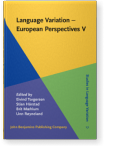Voicing the ‘other’
Code-switching in discourses of Gaelic language ideologies
Since the late 1970s, and particularly the early 1990s, work carried out on language ideologies within the fields of linguistic anthropology and the sociology of language has contributed considerably to an understanding of the interplay between speakers’ language use on the one hand, and their views and beliefs about language and its use on the other. At the same time, ongoing research into the phenomenon of code-switching within interactional sociolinguistics has demonstrated the multiple motivations that multilingual speakers may have in alternating between the various codes available to them. This paper provides a preliminary synthesis of the two approaches in the context of Scottish Gaelic-English bilinguals’ interactions, drawing on two corpora of recorded bilingual speech to look at how language choice can relate to expressions of language ideologies and the interactional contexts in which these expressions take place. We focus specifically on how speakers orient to language ideologies related to language policy and argue that code-switching offers the interactant a way to “voice the other” when expressing negative views of language policy and practice. We then consider the interactional motivations for drawing on this “other” voice in the discourse.
References (26)
References
Ag, Astrid, and J. Normann Jørgensen 2013. “Ideologies, norms, and practices in youth poly-languaging”. International Journal of Bilingualism 17 (4): 525–539. 

Alvarez-Cáccamo, Celso. 1996. “The power of reflexive language (s): Code displacement in reported speech.” Journal of Pragmatics 25(1): 33–59. 

Auer, Peter. 1988. “A conversation analytic approach to code-switching and transfer.” In Code-switching: Anthropological and Sociolinguistic perspectives ed. by M. Heller, 187–213. Berlin: Mouton de Gruyter. 

Bakhtin, Mikhail. M. 1986. Speech Genres and Other Late Essays. (C. Emerson, M. Holquist, and Vern W. McGee, eds.). Austin: University of Texas Press.
Brown, Penelope, and Stephen C. Levinson 1978. Politeness: Some Universals in Language Usage. Cambridge: Cambridge University Press.
Clyne, Michael. 1967. Transference and Triggering: Observations on the Language Assimilation of Postwar German-speaking Migrants in Australia. The Hague: Martinus Nijhoff.
Dorian, Nancy C. 1997. “Telling the monolinguals from the bilinguals: Unrealistic code choices in direct quotations within Scottish Gaelic narratives.” International Journal of Bilingualism 1: 41–54.
Du Bois, John W. 2007. “The stance triangle.” In Stancetaking in Discourse: Subjectivity, Evaluation, Interaction ed. by R. Englebretson, 139–182. Amsterdam: John Benjamins. 

Dunmore, Stuart S. 2014. “Bilingual Life After School? Language Use, Ideologies and Attitudes Among Gaelic-medium Educated Adults.” Unpublished PhD thesis: University of Edinburgh.
Gal, Susan. 1979. Language Shift: Social Determinants of Linguistic Change in Bilingual Austria. New York: Academic Press.
García, Ofélia, and Li Wei 2014. Translanguaging: Language, Bilingualism and Education. Basingstoke: Palgrave Macmillan.
Jørgensen, J. Normann 2003. “Languaging among fifth graders: Code-switching in conversation 501 of the Køge project.” Journal of Multilingual and Multicultural Development 24 (1–2): 126–148. 

Kroskrity, Paul., ed. 2000. Regimes of Language: Ideologies, Politics, and Identities. Santa Fe, NM: School of American Research Press.
National Records of Scotland (NROS). 2013. “
Statistical Bulletin – Release 2A
”. Available online: <[URL]> [accessed 26.9.2013].
Oliver, James. 2006. “Where is Gaelic? Revitalisation, language, culture, and identity”. In Revitalising Gaelic in Scotland ed. by W. McLeod, 155–168. Edinburgh: Dunedin Academic Press.
Rampton, Ben. 2005. Crossing: Language and Ethnicity Among Adolescents (2nd edn). London: Routledge.
Schiefflin, Bambi, Kathryn Woolard and Paul Kroskirty, eds. 1998. Language Ideologies: Practice and Theory. New York: Oxford University Press.
Silverstein, Michael. 1979. “Language structure and linguistic ideology”. In The Elements: A Parasession on Linguistic Units and Levels ed. by R. Clyne, W. Hanks, and C. Hofbauer, 193–247. Chicago: Chicago Linguistics Society.
Smith-Christmas, Cassie. 2012. “I’ve lost it here de a bh’ agam: Language Shift, Maintenance, and Code-Switching in a Bilingual Family.” Unpublished PhD thesis: University of Glasgow.
Stockdale, Aileen, Bryan MacGregor and Gillian Munro 2003. Migration, Gaelic-medium Education n and Language Use. Sleat, Isle of Skye: Ionad Nàiseanta na h-Imrich [National Migration Centre], Sabhal Mòr Ostaig.
Tannen, Deborah 1995. “Waiting for the mouse: Constructed dialogue in conversation.” In The Dialogic Emergence of Culture ed. by B. Mannheim and D. Tedlock, 198–217. Philadelphia: University of Pennsylvania Press.
Zentella, Ana Celia 1990. “Integrating Qualitative and Quantitative Methods in the Study of Bilingual Code Switching.” Annals of the New York Academy of Sciences 583: 75–92. 

Cited by (2)
Cited by two other publications
Nance, Claire Louise & Dominic Moran
2022.
Place identity and authenticity in minority language revitalisation: Scottish Gaelic in Glasgow.
International Journal of Bilingualism 26:5
► pp. 542 ff.

Dunmore, Stuart S.
2017.
Immersion education outcomes and the Gaelic community: identities and language ideologies among Gaelic medium-educated adults in Scotland.
Journal of Multilingual and Multicultural Development 38:8
► pp. 726 ff.

This list is based on CrossRef data as of 24 july 2024. Please note that it may not be complete. Sources presented here have been supplied by the respective publishers.
Any errors therein should be reported to them.
